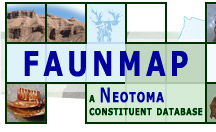|

















|
 |
DATA ACQUISITION PROCESS
Data was entered for more than 5000 fossil localities (see the mapping interface for the complete count), and were acquired in two stages, FAUNMAP I and FAUNMAP II. For both FAUNMAP I and FAUNMAP II, data extraction and entry involved the following:
The process began with the extraction from primary bibliographic references of the specimen and locality information for the relevant time periods. Additional localities were discovered by following the paper trail from one paper's bibliography to another. To be included, taxa had to be represented by a voucher specimen, localities had to be described well enough to be geographically placed at least in a county, and an age assignment (radiocarbon, biochronologic, stratigraphic, or other accepted technique) had to be derivable from the information provided in the publication. While attempts were made to include all peer-reviewed publications, those publications (primarily those from before the 1950s) that lacked temporal control were not included unless later work added the needed temporal information. All information was keyed using individual localities. However, some publications only included faunal lists that aggregated taxa from numerous localities without attributing any of those taxa to specific localities. These faunas were entered as single locality entries.
Information extracted from the literature was coded in a standard way as specified in the FAUNMAP data tables.
All items in the database contain entries in the Locality Table, Faunal Table, Relative Age Table, and Electronic Bibliography. It was not always possible to fill all of the data fields in these or the other tables, but as much information as was available from the published literature was utilized. Blank fields in the data tables mean that the information was not found in the published literature.
|





